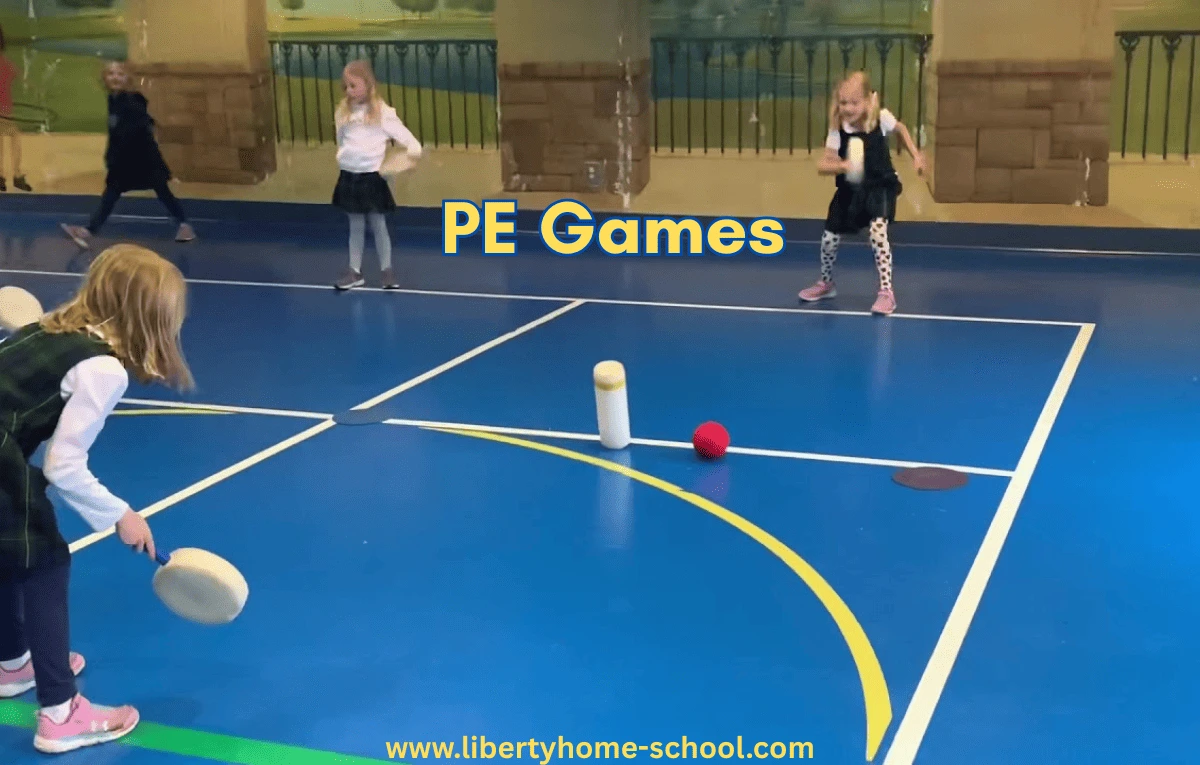Homeschool PE Games for 10-Year-Olds: 15 Fun & Fit At-Home Activities
Keeping your 10-year-old active at home can actually be a blast! Whether you’re homeschooling or just looking for some fun ways to help them burn off that extra energy indoors, these 15 easy PE Games require minimal space and equipment—and they guarantee loads of fun and fitness!
1. 9 Square
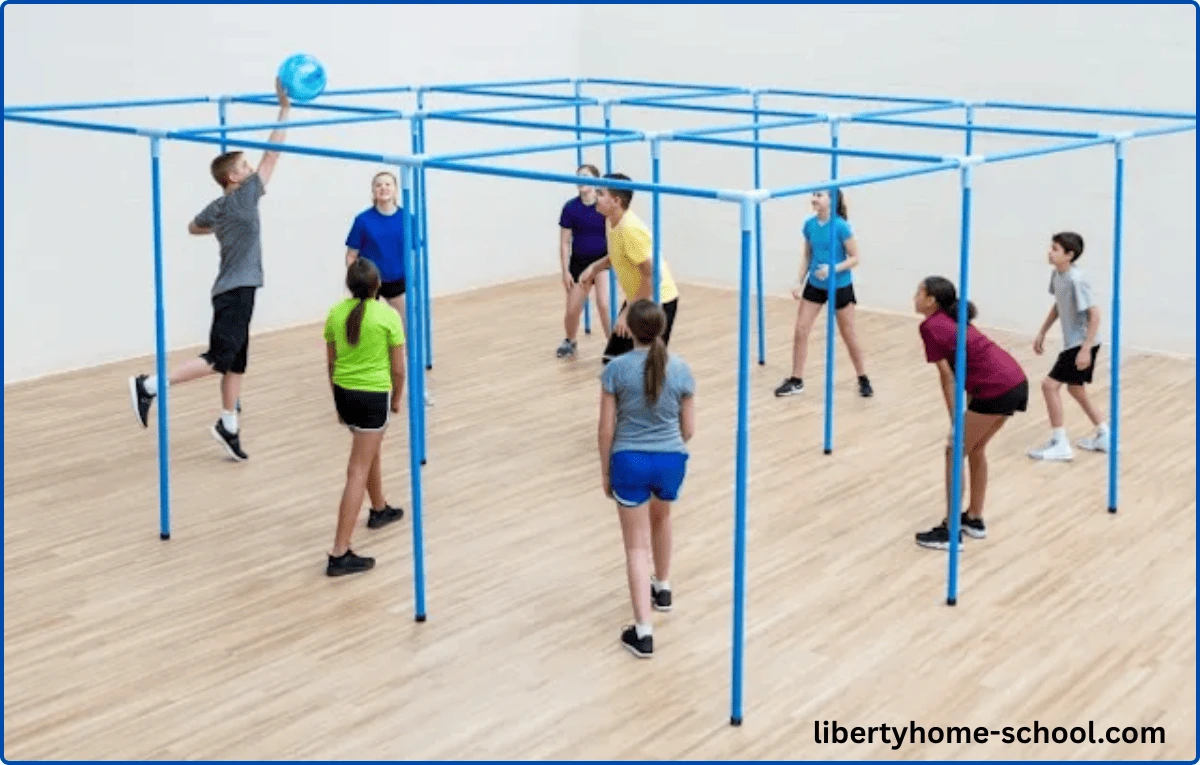
9 Square is a fun blend of volleyball and four square, making it a fantastic game for kids to enjoy indoors. You’ll need a special Nine Square court, which features nine squares set up in a 3×3 grid.
What’s really cool is that nine players can join in at once! The aim is to get to and stay in the center square, known as the King or Queen square. If you miss the ball or send it out of bounds, you’ll have to move down a square while others move up. And if you drop the ball, you’re out of the game!
This game keeps everyone active and entertained. It’s perfect for those rainy days or during PE classes since kids can easily join or leave, and the game keeps evolving. Plus, it fosters a spirit of friendly competition without being overly challenging.
2. Zombie Tag

Zombie Tag: A Fun PE Games for 10-Year-Olds
Imagine a classic game of tag, but with a spooky twist—here, the “zombies” are on the hunt to tag the other players!
Once tagged, those players turn into zombies and join in on the fun of chasing down their friends.
This game is fantastic for boosting speed, agility, and teamwork skills.
It’s perfect for playing in the backyard or at the gym during homeschool PE sessions.
Plus, it keeps kids active and engaged while they’re having a blast!
3. Yoga and Pilates
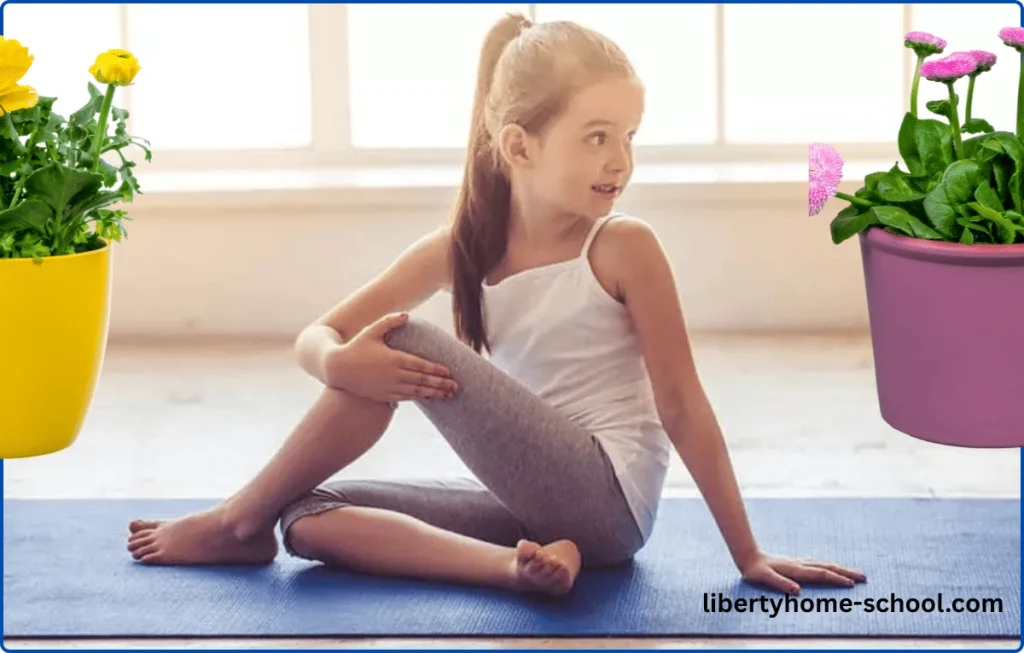
Yoga and Pilates are not just calm; they’re also powerful fitness choices for 10-year-olds. These mindful exercises enhance flexibility, balance, strength, and body awareness—all while helping kids feel relaxed and focused. It’s a fantastic way to kick off or wrap up your homeschool PE routine, whether you’re in the living room, playroom, or even enjoying the outdoors on the grass.
Why parents appreciate this
- No special equipment is required (just a mat or towel!)
- Simple to follow with YouTube videos or printed poses
- Promotes good posture, concentration, and emotional balance
- Low-impact, ideal for rainy days or laid-back mornings
Give these easy poses a try
- Cat-Cow Stretch
- Downward Dog
- Tree Pose
- Child’s Pose
- Bridge Pose
- Seated Twist
Bonus Tip: Encourage your child to lead a fun 10-minute yoga “class” to boost their confidence!
4 Gaga Ball
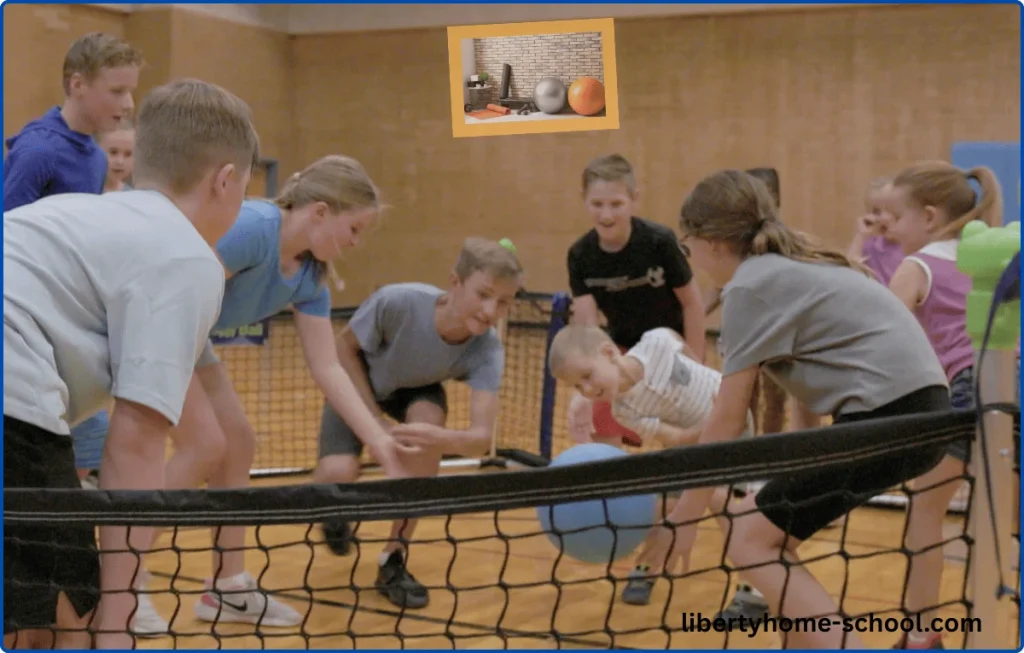
Gaga Ball is an energetic and fast-paced game that’s just right for 10-year-olds and can be easily adapted for homeschool PE. Often referred to as a safer version of dodgeball, it’s played in a small enclosed area known as a pit, where players aim to hit others below the knee with a soft ball. It’s a blast, safe, and gets kids moving, dodging, jumping, and laughing—all rolled into one game!
It’s no wonder this is one of the most popular indoor and backyard PE games for kids in the U.S. It perfectly blends excitement with skill-building and fair play.
Why parents love this
- Perfect for homeschooling PE Games for 10-year-olds
- Helps burn off energy while teaching reflexes and strategy
- A safe alternative to dodgeball—no hard hits
- Simple to play with a softball and a DIY boundary (like pool noodles or cones)
- Kids can play independently once the rules are established
Quick How-To Play
- Players start inside the pit (a circle or square area).
- One person tosses the ball into the air.
- It must bounce once before the game kicks off.
- Players hit the ball (not catch it) with an open hand to tag others below the knee.
- If you get hit, you’re out. The last one standing wins!
5. Captain, Yes Captain
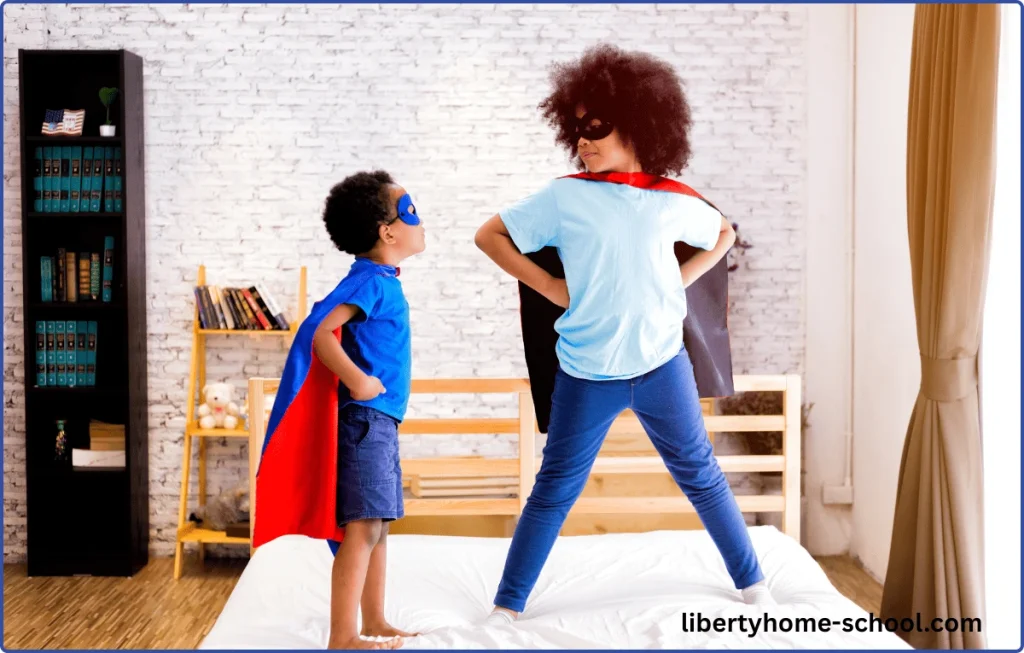
“Captain, Yes Captain” is a lively and fun game where one child takes on the role of the “captain” and issues silly commands like “jump in place,” “crawl like a crab,” or “march like a soldier.” The other players must respond with a cheerful “Yes, Captain!” before they dive into the action.
This game has become a favorite among homeschooling families in the USA because it promotes listening skills, leadership, and physical activity—all while keeping the atmosphere light and entertaining. The best part? It’s perfect for small spaces, whether you’re indoors in the living room or outside in the backyard.
Why parents love this
- Enhances listening skills and the ability to follow directions
- Sparks creative movement and imagination
- Great for siblings or solo play (with a parent or a timer)
- No special equipment needed—just bring your energy and creativity
- Fosters leadership skills in a fun, engaging way
How to Play
- Select one player to be the “captain.”
- The captain gives fun movement commands (like “Hop like a frog!”).
- The other players respond with “Yes, Captain!” and then follow the command.
- If someone forgets to say “Yes, Captain,” they take a break for one turn.
- Switch captains every 3–5 minutes.
6 Animal Walk Races
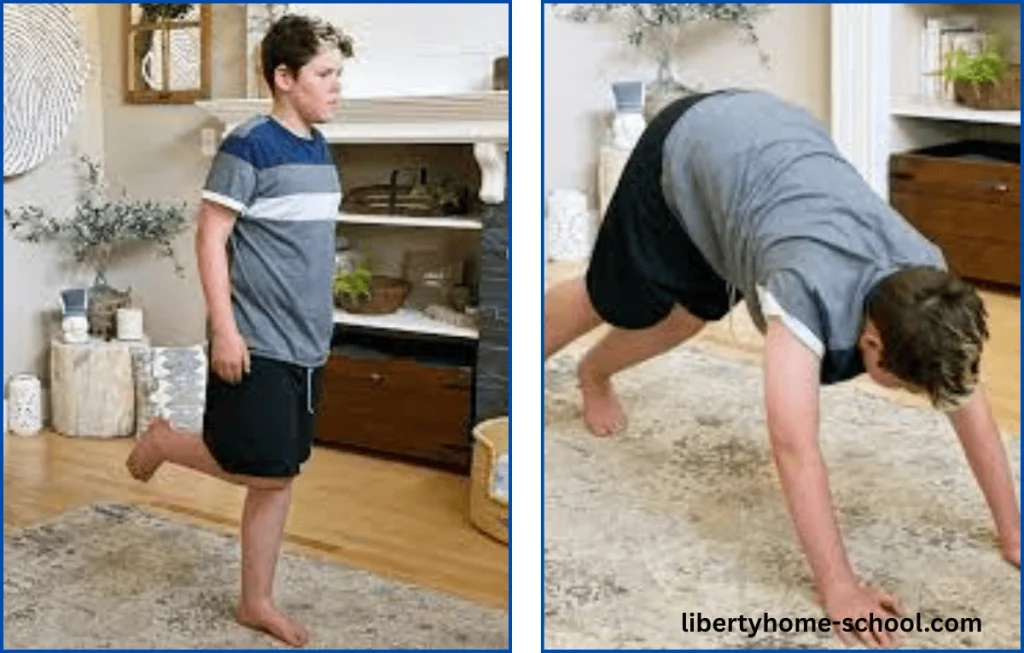
Animal walk races are an awesome way to boost strength, coordination, and giggles—all while pretending to be your favorite animals! Kids can crawl, hop, or waddle around like bears, frogs, or penguins. It’s a silly and active game that works perfectly for both indoor and backyard homeschool PE sessions.
This game has become one of the most popular ideas on Pinterest because it’s simple, requires no equipment, and keeps kids moving in creative ways that help build muscles and improve motor skills.
Why parents love this:
- No setup required—just some space to move around
- Enhances core strength and coordination
- A fantastic way to burn off energy during homeschool breaks
- Suitable for solo play or fun with siblings
- Easily adaptable for any space or age group
Try These Animal Walk Ideas:
🐻 Bear Crawl—Get on hands and feet
🐸 Frog Jump—squat down and leap forward
🐧 Penguin Waddle—Keep arms at your sides and shuffle walk
🐍 Snake Slither – slide on your belly
🦀 Crab Walk—hands and feet behind you, belly facing up
You can even turn these movements into a race or an obstacle course for some extra fun!
7 Dance Freeze
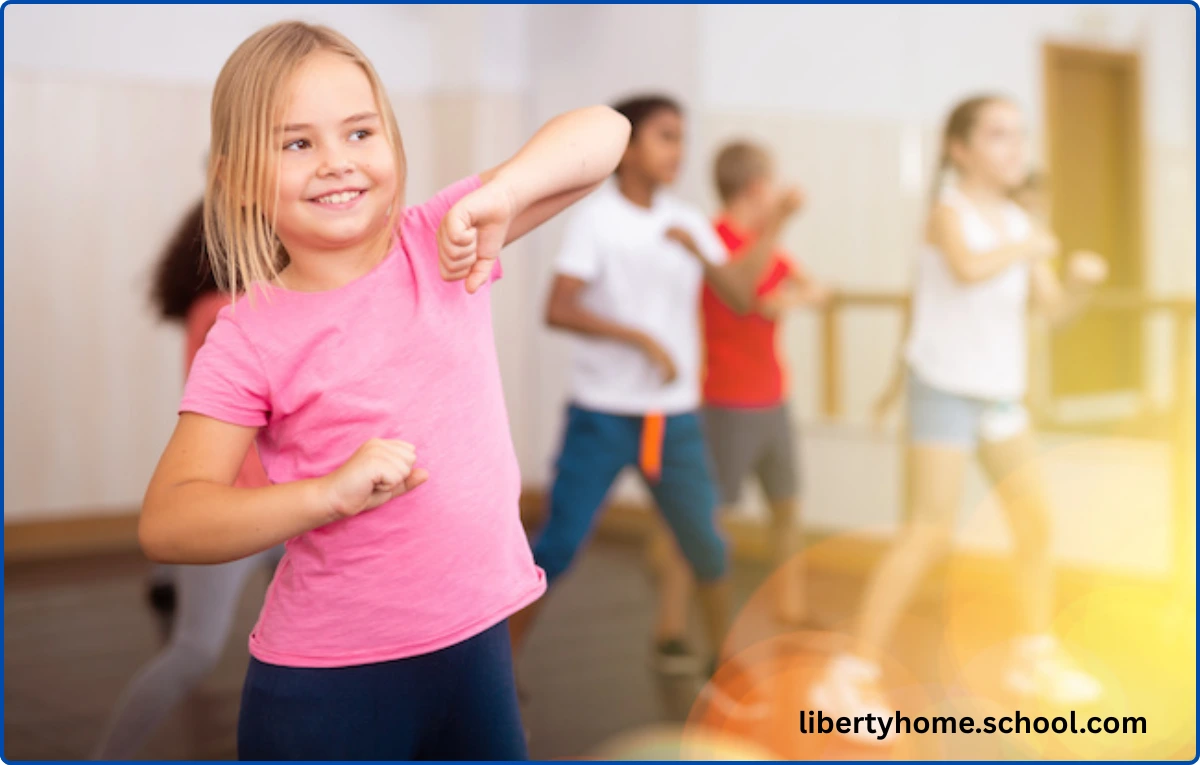
A High-Energy Indoor PE Game for 10-Year-Olds
Dance Freeze is a beloved homeschool PE activity that mixes movement, music, and tons of giggles! Just play a catchy song and let your kids dance their hearts out—until you suddenly hit pause on the music. When it stops, they have to freeze like statues. If they move, they’re out for that round.
It’s a go-to game for parents in the USA looking to burn off energy indoors on rainy days. Plus, it helps kids develop rhythm, focus, and self-control.
Why parents love this
- Super simple setup—just music and space
- Builds body awareness, timing, and control
- Perfect for solo play, siblings, or a whole PE class
- Works great in living rooms, bedrooms, or garages
- Endless fun with favorite songs and silly moves
How to Play
- Choose a playlist filled with upbeat, kid-friendly songs
- Let your child dance however they like
- Randomly pause the music—when it stops, they must freeze
- Anyone who moves sits out or has to do a funny challenge (like a crab walk)
- The last one dancing wins, or just keep playing for fun!
8 Musical Chairs
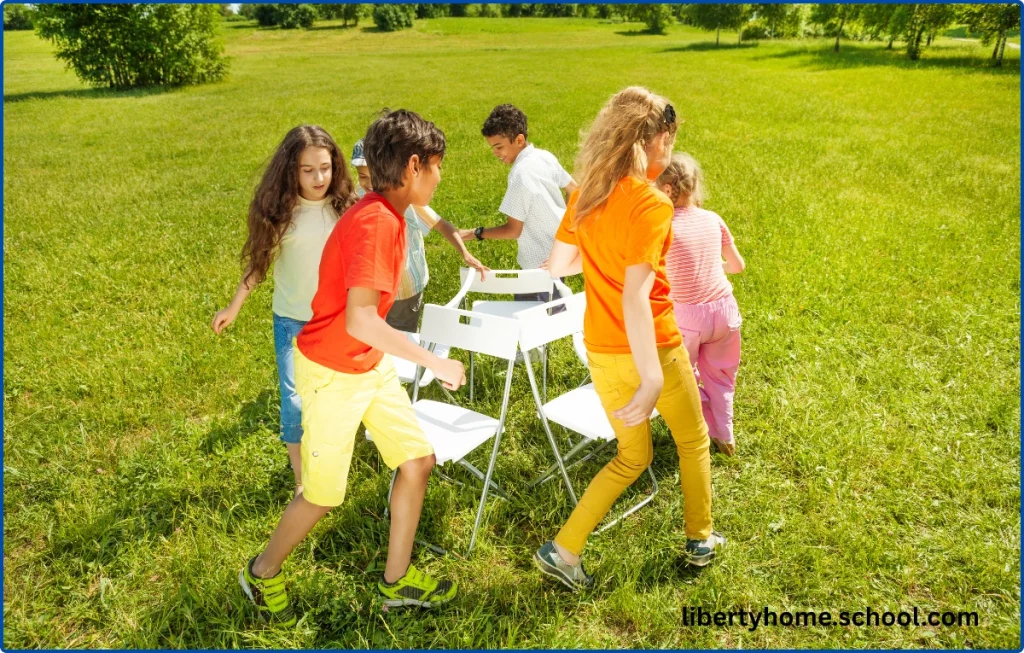
Musical Chairs is a classic that never goes out of style! It’s a fantastic way to get kids moving, sharpen their listening skills, and enjoy some friendly competition—all of which makes it a perfect fit for homeschool PE. All you need are a few chairs and some lively music. As the tunes play, the kids walk or dance around the chairs, and when the music stops, they rush to find a seat. Each round, one chair gets taken away until there’s just one child left standing.
This game is super popular on Pinterest among homeschoolers in the USA because it’s simple to set up, incredibly fun, and works great for small groups or family gatherings.
Why parents love this
- It’s a fantastic way for kids to release energy and manage their emotions.
- It teaches focus, timing, and quick decision-making.
- No need for fancy gear—just some music and chairs!
- It can be played indoors or outdoors.
- It promotes laughter, resilience, and a spirit of friendly competition.
How to Play
- Set up one less chair than the number of players.
- Play some upbeat music while the kids walk around the chairs.
- Randomly pause the music—kids need to find a seat quickly!
- The last one standing is out for that round.
- Remove one chair and keep going until there’s a final winner.
Tip: Spice things up with themed music or fun challenges like “hop on one foot” or “dance in slow motion”!
9 Balloon Volleyballs
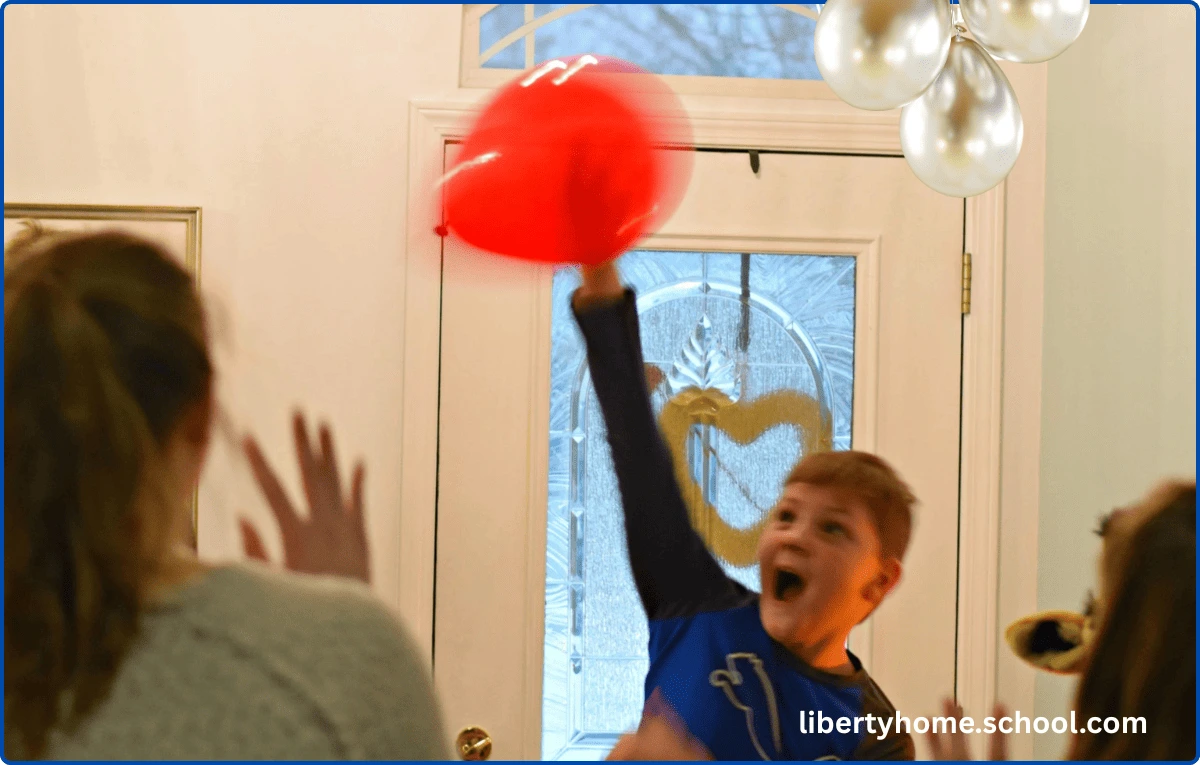
Balloon Volleyball is a super fun, low-risk twist on traditional volleyball that’s just right for living rooms, playrooms, or backyards. All you need is a balloon and a string or ribbon to make a “net.” Kids can hit the balloon back and forth, trying their best to keep it from touching the floor.
This homeschool PE favorite has become a hit among parents in the USA on Pinterest and Facebook because it’s safe, enjoyable, and can be adapted for different age groups—even siblings can join in on the fun!
Why parents love this
- Safe for indoor play—even in cozy spaces
- Boosts hand-eye coordination and balance
- No fancy equipment needed—just a balloon and some string
- Perfect for solo practice or two-player games
- Keeps kids entertained and active without screens
How to Play
- Tie a string between two chairs to set up a net
- Blow up a balloon (or two!)
- Two players take their positions on opposite sides
- Hit the balloon over the net—just make sure it doesn’t touch the ground!
- Score a point if the balloon lands on the opponent’s side
- First to reach 10 (or 15) points wins—rotate players if you have a group
💡 Variation: For an extra challenge, use a beach ball or let younger kids catch and toss instead of volleying.
10 Speedball

A High-Energy PE Game for 10-Year-Olds
Speedball is an exhilarating blend of soccer, handball, and basketball, perfectly suited for your backyard or even a cozy living room with a soft ball. It’s the ultimate way for kids to burn off energy, enhance their coordination, and foster teamwork—all without the need for any fancy gear.
This game is quickly becoming a favorite for homeschool PE, especially on platforms like Pinterest, as it offers active 10-year-olds the thrilling challenges and friendly competition they crave.
Why parents love this
- It combines several sports into one exciting activity
- Helps build stamina, agility, and ball-handling skills
- Perfect for larger families or small homeschool groups
- Great for backyard PE sessions or cleared-out living spaces
- Promotes strategy, teamwork, and good sportsmanship
How to Play (Home Version)
- Grab a soft ball and set up two end zones using cones, pillows, or chalk
- Players can kick the ball (like in soccer) or pass it by hand (like in basketball)
- You can’t run while holding the ball—you must either pass it or drop it
- Score by getting the ball into the opposing team’s goal or end zone
- The first team to reach 10 points wins—or you can play for 10 minutes
💡 Variation: For a 1-on-1 match, use a hallway and mark goals with tape. Even just two players can have a blast with some simplified rules!
11 Hula Hoop Tic Tac
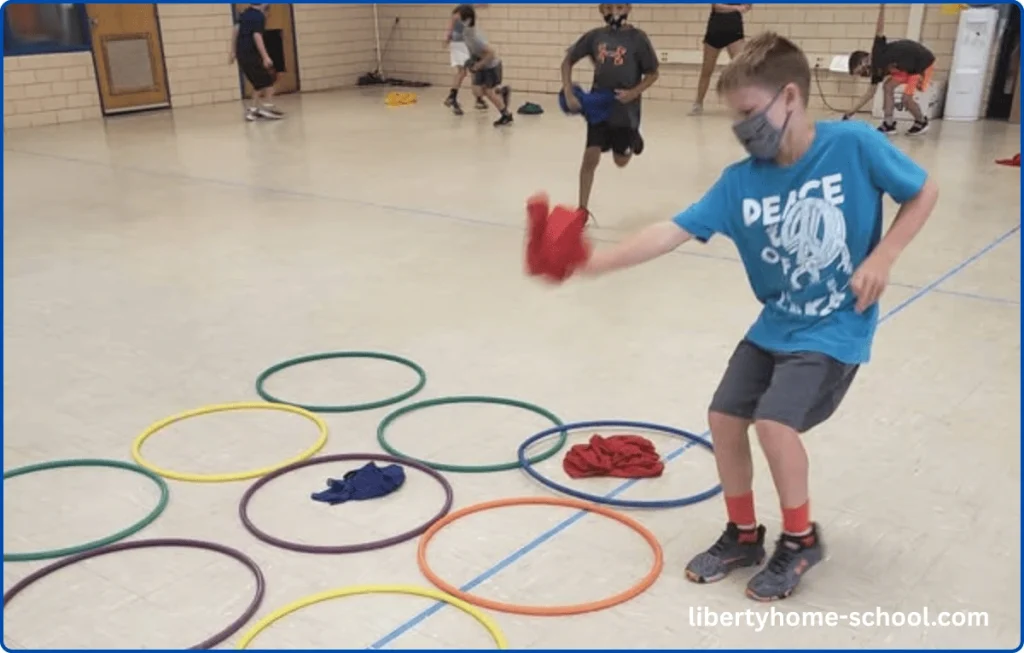
Hula Hoop Tic Tac Toe is the perfect blend of strategy, speed, and movement, making it an exciting addition to your homeschool PE lineup. All you need are 9 hula hoops and two sets of colorful beanbags or soft items. Arrange the hoops in a 3×3 grid, just like a tic-tac-toe board, and let the kids dash to place their markers in the hoops to claim their spots.
This game has become a favorite among homeschooling moms on Pinterest because it encourages kids to think critically while staying active, fits well in smaller spaces, and can easily be adapted for siblings or larger homeschool groups.
Why parents love this
- Encourages critical thinking and physical coordination
- Simple setup with items most families already have
- Perfect for solo play, head-to-head matches, or team competitions
- Engages both the mind and body
- Fun for everyone—even adults can join in!
How to Play
- Arrange 9 hula hoops in a 3×3 grid on the floor
- Divide the kids into two teams or players, each with different colored markers (like bean bags or socks)
- On “go,” each child takes turns running to place their marker in a hoop
- The first player to get 3 in a row wins
- You can rotate players or keep score in a tournament style
💡 Variation: Time each child individually and run multiple rounds to boost focus, speed, and memory!
12 Dodgeball
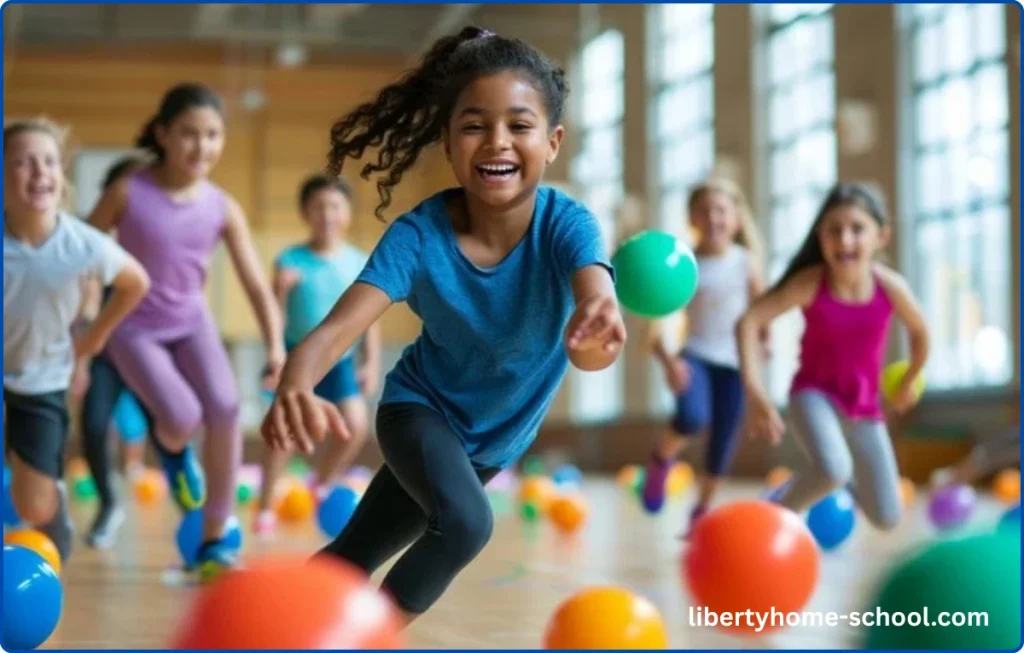
Dodgeball is one of the most thrilling and effective indoor games to keep kids moving. It fosters team spirit, hones coordination, and promotes quick thinking—making it an ideal choice for both organized homeschool PE sessions and spontaneous playtime.
Why It’s Perfect for 10-Year-Olds:
- Boosts cardiovascular fitness
- Enhances aim and reaction time
- Develops communication and strategic skills
- Can be played indoors or outdoors with minimal setup
- Super fun and competitive—kids won’t even notice they’re exercising!
What You’ll Need:
- 6–8 soft rubber or foam balls
- A spacious area (living room, basement, or backyard)
- A centerline marked with tape, string, or cones
How to Play: The Basics
- Split players into two teams
- Place the balls in the center of the play area
- On the count of three, both teams dash to grab a ball
- Players aim to hit opponents below the shoulders
- If you get hit, you’re out—but not for long!
Version 1: Classic Dodgeball
- Players who are “out” wait in a line outside the game
- If a teammate catches a ball in mid-air, the thrower is out
- The catching team can bring one player back into the game
- This version teaches accuracy, agility, and teamwork
Version 2: Backstabber Dodgeball (Best for older or advanced kids)
- Out players stand behind the opposing team
- If a backstabber hits a player, that player is out
- The backstabber rejoins their team
- Requires alertness, strategy, and awareness of all directions
Why Parents Appreciate It?
- High-energy and easily adaptable for indoor play
- Promotes fitness and problem-solving skills
- Perfect for families with multiple siblings or homeschool co-ops
- Keeps kids off screens and fully engaged
- No expensive equipment needed
13 Spikeball: Fast, Fun, and Perfect for PE at Hom
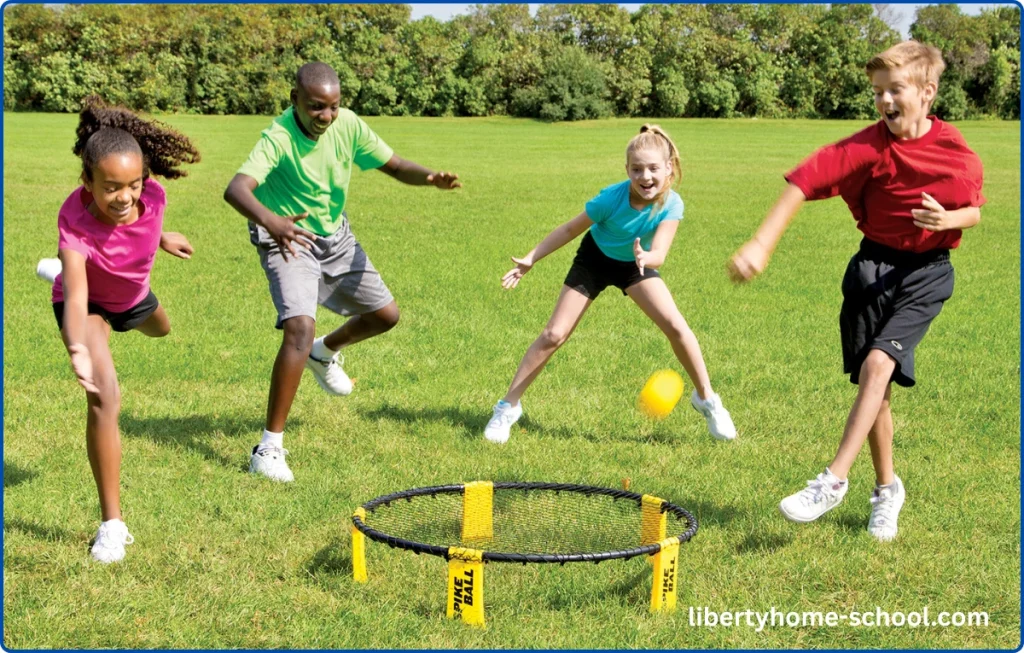
Spikeball is an exciting, high-energy game that keeps 10-year-olds engaged, active, and giggling. Imagine a fun blend of volleyball and foursquare, all centered around a small round net. It’s compact enough to play indoors (just use soft balls) and competitive enough to challenge older kids.
Why It’s Perfect for 10-Year-Olds?
- Sharpens reflexes and hand-eye coordination
- Builds teamwork and communication skills
- Burns off energy with fast-paced fun
- Great for 2–4 players, even in cozy spaces
- Easily played indoors with a foam ball option
What You Need
- A Spikeball set (or any small round net + soft ball)
- 3–4 players
- 6–10 feet of open floor space
How to Play: Basic Rules
- Set the round net in the center of your play area.
- Two teams of two players each stand around the net.
- One player serves the ball onto the net, making it bounce up.
- The opposing team has up to 3 hits (like in volleyball) to bounce the ball back onto the net.
- The game continues until a team misses the net or the ball hits the ground.
Version 1: Indoor Foam Ball Challenge
- Use a lightweight foam ball for indoor play.
- Form smaller teams (2 players only) for tighter spaces.
- Play in your living room, basement, or garage without worrying about damage.
Version 2: Backyard Tournament
- Set up in the yard with your standard Spikeball gear.
- Organize a mini tournament with scorecards and time limits.
- Perfect for homeschool PE groups or family fitness days.
Why Parents Love It?
- Compact and portable
- Encourages friendly competition and movement
- Works well for small families or homeschool co-ops
- Promotes social interaction and fair play
- A fantastic alternative to screen time or passive play
14 Keep the Ball Up: Simple, Silly, and Surprisingly Effective PE
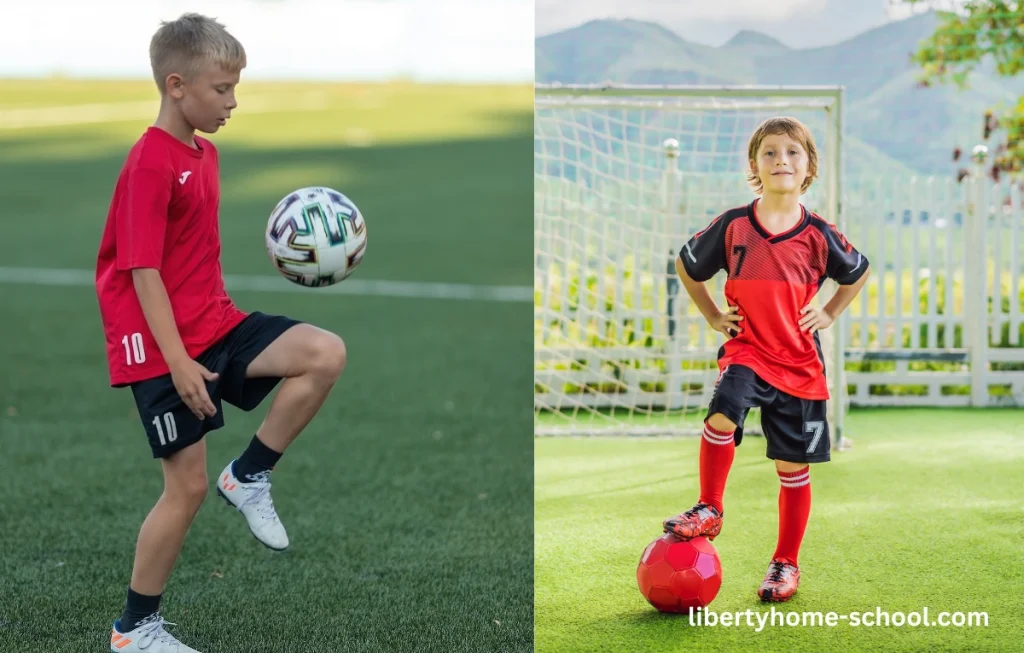
Keep the Ball Up” is a super easy, low-mess game that can keep 10-year-olds giggling and active for ages. This game focuses on teamwork, balance, and quick reflexes—and it’s perfect for small spaces, busy schedules, and energetic kids.
Why It’s Great for 10-Year-Olds?
- Encourages quick thinking and coordination
- Can be played alone or with friends
- Ideal for rainy days or indoor PE classes
- Keeps kids moving and their minds sharp
- No special equipment or setup required
What You Need?
- 1 inflated balloon (or more)
- Some open floor space (like a living room, hallway, or playroom)
How to Play?
The Basic Version
- Blow up a balloon
- Toss it into the air
- The goal is simple: Don’t let it hit the ground!
- Players can use their hands, feet, heads, elbows—anything but the floor—to keep the balloon up
- If it falls, just restart the timer or the round
Version 1: Team Challenge Mode
- Two or more players work together to keep one balloon afloat
- Count how many taps they can manage without it dropping
- Take turns and keep track of the highest scores
Version 2: Multi-Ball Mayhem (for a giggly challenge)
- Add 2 or 3 balloons into the mix
- Fantastic for improving agility and focus
Why Parents Love It?
- Safe for indoor play—no worries about damaging furniture
- Requires no setup and is completely free
- Keeps kids active, laughing, and engaged
- Perfect for brain breaks between lessons
- Works well in tight spaces or for solo play
15 Floor is Lava

The Floor is Lava” isn’t just a goofy game—it’s a clever way to boost your child’s balance, agility, coordination, and creativity. This fun-filled game is ideal for homeschool PE sessions because it combines physical activity with problem-solving, and the best part? You can set it up using items you already have at home!
Why It’s a Hit with 10-Year-Olds?
- It’s like creating an indoor obstacle course
- Promotes movement, decision-making, and spatial awareness
- Perfect for solo play or group challenges
- Can be adjusted to be easy or tough based on your child’s skill level
What You’ll Need?
- Pillows, yoga mats, cushions, books, cardboard pieces—anything flat and safe to step on
- A clear space (living room, hallway, playroom)
- A sprinkle of imagination!
How to Play?
- Shout out, “The floor is lava!”
- Players must leap onto objects and avoid touching the ground
- Navigate from one spot to another without falling into the “lava”
- Add fun challenges like collecting items, doing jumping jacks, or balancing on one foot
Version 1: Timed Lava Run
- Set up markers around the room
- Start a timer and see how quickly you can cross the room without touching the floor
Version 2: Command Lava Mode
- A parent or sibling calls out fun challenges:
- “Touch something red!”, “Crawl under the chair!”, “Hop three times!”
Keeps the game exciting and sharpens listening skills too
Why Parents Appreciate It
- No cost, no preparation needed
- High-energy, safe indoor movement
- A simple way to break up screen time or lengthy lessons
- It helps build core strength, coordination, and confidence
- Kids stay active and engaged without needing a big space
FAQs
- What age group are these games suitable for?
These games are a blast for kids aged 4 to 12! You can easily tweak the activities to make them easier or harder, depending on the age of the kids involved. - Are these games safe to play indoors?
Absolutely! Games like Dance Freeze, Balloon Volleyball, and Keep the Ball Up are perfect for indoor play, as long as you have some soft materials and enough space to move around. - How many kids can participate in each game?
Most of these games can accommodate anywhere from 2 to over 10 kids. For instance, Dodgeball and Musical Chairs work best with larger groups, while games like Spikeball or Hula Hoop Tic Tac Toe are great for smaller teams. - Do these games require any special equipment?
Not really! Most games just need everyday items like balloons, hula hoops, balls, or some music. You can easily improvise with what you have at home or school, making it budget-friendly. - How can these games help my child’s development?
These games are fantastic for promoting physical fitness, social skills, coordination, teamwork, listening skills, and even critical thinking—especially in games like Tic Tac Toe or Speed Ball. - Can I use these games in a homeschool setting?
Definitely! They’re perfect for homeschoolers. They’re not only fun and educational but also help kids take active breaks between their learning sessions. - Are these games appropriate for birthday parties or group events?
Yes, they’re a huge hit at parties, family gatherings, and community events. They keep kids engaged and active with very little setup required. - How do I manage different skill levels among kids?
You can adjust the rules or create balanced teams. For example, pairing older kids with younger ones can encourage cooperation and fair play. - Do these games help with screen-free playtime?
For sure! These activities are designed to get kids off screens and into action, laughing and connecting with their friends in real life. - Can these games be played in small spaces?
Yes! Games like Keep the Ball Up, Dance Freeze, and Balloon Volleyball can easily be played in living rooms, classrooms, or backyards.
Also Read:
Creative Writing Prompts for 10-Year-Olds

